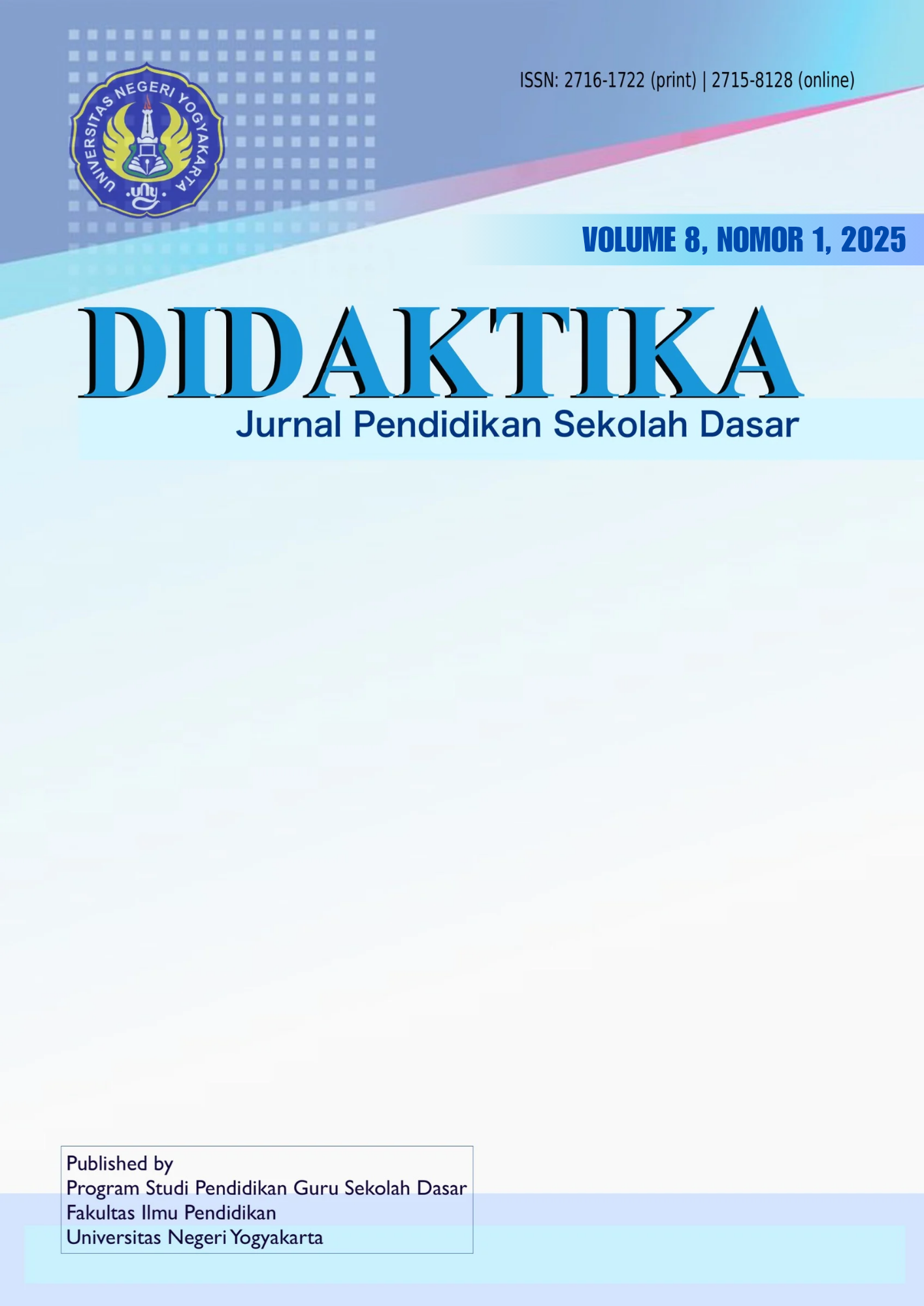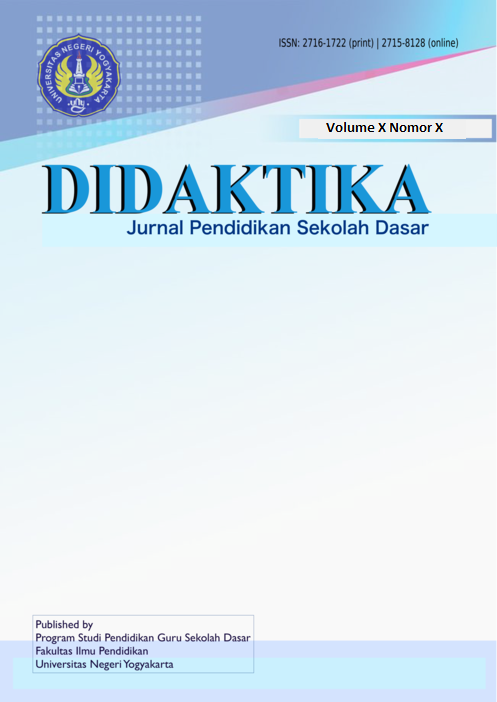Application of Field Trip Method to Support Elementary School Children In Learning Sains Material Of Living Things
Abstract
References
AF, M. A., Nurfadilah, K., & Hilman, C. (2022). Out-of-School Education in the Framework of Lifelong Education. Journal of Innovation, Evaluation and Learning Development (JIEPP), 2(2), 90-95. DOI: https://doi.org/10.54371/jiepp.v2i2.216
Afifah, N., Sari, E. P., & Lestari, R. (2017). Development of Integrated Science Student Worksheets (Lks) Oriented Contextual Teaching and Learning (Ctl) on the Material Characteristics of Living Things Class VII at SMP Negeri 1 Rambah Hilir (Doctoral dissertation, Pasir Pengaraian University).
Anisa, A., Kinanti, F. M., Panjaitan, A. R. A., & Octaviani, R. (2022). Breeding and growth of living things. Tambusai Education Journal, 6(1), 203-205.
Anisatun Nur Laili. (2020). The Concept of Informal Education in the Perspective of Ibn Sahnun (Review of Kitab Adab Al-Muallimin). Indonesian Journal of Islamic Education Studies (IJIES), 3(1), 31-47. DOI: https://doi.org/10.33367/ijies.v3i1.1133
Bariyah, S. K. (2019). The role of the three centers of education in shaping children's personality. Journal of Education, 7(2), 228-239. DOI: https://doi.org/10.24090/jk.v7i2.3043
Clayton, S. (2017). Zoos and Aquariums as Informal Learning Environments for Climate Change Communication. Oxford: Oxford University Press.
Dhi Bramasta, Sutomo and Sriyanto. (2022). Social Studies Learning Innovation with the Implementation of Field Trip Method. Proceedings of Social Studies Learning Challenge in the 21st Century. DOI: https://doi.org/10.30595/pssh.v3i.386
Dr. Mursalim, M.Pd., M. I. T. (2019). Building Interconnections between Formal, Non-Formal, and Informal Education. Researchgate, August 2008, 1-10.
Effendi, R., Salsabila, H., & Malik, A. (2018). Understanding the sustainable environment. Modul, 18(2), 75-82. DOI: https://doi.org/10.14710/mdl.18.2.2018.75-82
Fatmawati, E. (2020). Cooperation between parents and teachers in increasing students' learning motivation. IBTIDA', 1(2), 135-150. DOI: https://doi.org/10.37850/ibtida.v1i2.147
Hidayah, N. W. (2020). Teaching Book for the Growth and Development of Living Things in Madrasah Ibtidaiyah. University of Muhammadiyah Sidoarjo.
Hindayati, I. (2023, February). Analysis of Field Trip Learning Methods on Student Learning Outcomes in Senior High School (SMA). Geography Science Education, Volume 4, 13-18. Retrieved from http://jurnal.unsil.ac.id/index.php/geosee/index
Ilma, N. (2015). The Main Capital of Building National Character. Journal of Islamic Education Management, 3(1), 82-87.
Komariah, Djam'an Satori and Aan. "Djam'an Satori and Aan Komariah, Qualitative Research Methodology, Bandung: Alfabeta, 2011, pp.25 20 19." (November 2017): 19-25.
Kristyowati, R., & Purwanto, A. (2019). Science literacy learning through environmental utilization. Scholaria: Journal of Education and Culture, 9(2), 183-191. DOI: https://doi.org/10.24246/j.js.2019.v9.i2.p183-191
Kurniawati, F. N. A. (2022). Reviewing the Problems of Low Quality Education in Indonesia and Solutions. Academy of Education Journal, 13(1), 1-13. DOI: https://doi.org/10.47200/aoej.v13i1.765
Lubis, Z., Ariani, E., Segala, S. M., & Wulan, W. (2021). Family education as the basis for children's education. Pema (Journal of Education and Community Service), 1(2), 92-106. DOI: https://doi.org/10.56832/pema.v1i2.98
Mahfuzhoh, E., & Saputra, A. (2020). Behavior of Children Visitors in Animal Educational Tourism Parks Case Study: Gembira Loka Zoo in Yogyakarta. Sinektika: Journal of Architecture, 17(1), 26-33.
Makkawaru, M. (2019). The Importance of Education for Life and Character Education in Education. Journal of Conception, 8(3), 116-119.
Miles, Mattew B. and A. Michael Huberman. 1992. Qualitative Data Analysis: A Sourcebook of New Methods. Translation of Tjetjep Rohendi Rohidi. Qualitative Data Analysis: A Sourcebook of New Methods. Jakarta: University of Indonesia Publisher (UI-PRESS).
Mudah, M. (2018). The Use of the Natural Environment as an Early Childhood Learning Resource on Children's Cognitive Development with the Theme of Kelomook B Plants at PAUD Anggrek Aluh-Aluh Kecil muara.
Nugraha, R. G. (2015). Improving Ecoliteracy of Elementary Students Through Fieldtrip Method of Economic Activities in Social Science Subjects. Jurnal Mimbar Sekolah Dasar, Vol 3(2), p. 60-72. DOI: https://doi.org/10.53400/mimbar-sd.v2i1.1322
Nugraha, Y. A. (2024). APPLICATION OF FIELD TRIP METHOD ASSISTED BY ENVIRONMENTAL MEDIA TO ELEMENTARY SCHOOL STUDENTS. JOURNAL OF BASIC EDUCATION SCIENCE ANALYSIS, 5(1), 1-4.
Nusi, K. (2016). Application of Field Trip Method in Improving Speaking Ability of Fifth Grade Students of SD Inpres 2 Tanamodindi Palu. e-Journal Bahasantodea, Vol 4(2), p 79-88
Risnawati, A. (2020). The Importance of Science Learning for Early Childhood Education. Proceedings of the Conference on Integration of Interconnection of Islam and Science, 2, 513-515.
Sari, W. A. S. (2021). The Importance of Science and the Role of Parents in Teaching Science to Children at Home. Ashil Journal: Journal of Early Childhood Education, 1(1), 52-66. DOI: https://doi.org/10.33367/piaud.v1i1.1572
Syaadah, R., Ary, M. H. A. A., Silitonga, N., & Rangkuty, S. F. (2023). Formal Education, Non-Formal Education and Informal Education. Pema (Journal of Education and Community Service), 2(2), 125-131. DOI: https://doi.org/10.56832/pema.v2i2.298
Trianingsih, R. (2016). Introduction to the practice of educating elementary school-age children. Al Ibtida: Journal of MI Teacher Education, 3(2), 197-211. DOI: 10.24235/al.ibtida.snj.v3i2.880
Zoo, Gembira Loka. (2024). Information related to Gembira Loka Zoo. https://gembiralokazoo.com/about-us
Downloads
Published
How to Cite
Issue
Section
Citation Check
License
Copyright (c) 2025 Desy Septia Kartikasari, Febrina Siska Widyaningtyas, Rahma Dyani Jelang Syafitri, Dora Natasya Napitupulu, Anisa Uswatun Khasanah

This work is licensed under a Creative Commons Attribution-ShareAlike 4.0 International License.
- Authors retain copyright and grant the journal right of first publication with the work simultaneously licensed under a Creative Commons Attribution License that allows others to share the work with an acknowledgement of the work's authorship and initial publication in this journal.
- Authors are able to enter into separate, additional contractual arrangements for the non-exclusive distribution of the journal's published version of the work (e.g., post it to an institutional repository or publish it in a book), with an acknowledgement of its initial publication in this journal.
- Authors are permitted and encouraged to post their work online (e.g., in institutional repositories or on their website) prior to and during the submission process, as it can lead to productive exchanges, as well as earlier and greater citation of published work.







